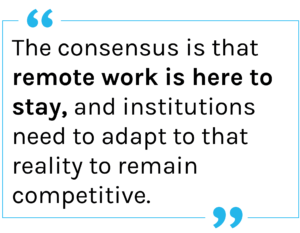The emergency shift to online learning and working in the spring of 2020 has had a permanent impact on higher education’s relationship with technology.

As the 2021 Changing Landscape of Education (CHLOE) report noted, the majority of respondents said that the pandemic had changed their institution’s priorities. To further these new priorities, educational technology adoption rates have soared since 2020. Hybrid work and virtual learning aren’t going anywhere, and the adoption of new technologies for every corner of campus means a connected ecosystem is more important than ever. Read on to learn more about the importance of unified tech for 2022.
What new tech is being adopted?
According to the CHLOE report, new focus areas for institutions in the wake of the pandemic include:
- expanding online program choices

- supporting online learning priorities and needs
- increasing flexibility to meet student needs
- applying quality standards to online courses
- accessibility for all students
- faculty training
- improved technical infrastructure
- and expanded online student services.
The e-learning market is expanding, but other aspects of campus life are going digital as well. Higher education institutions are moving procurement online. According to the 2021 B2B E-commerce in Evolution Report, by Amazon Business, “Nearly half (46 percent) of education buyers said supporting remote work and learning is a top priority for 2021.” Online purchasing makes distribution outside of a campus environment cheaper and easier.
Every department in a higher education institution is changing and digitizing. As learning management, student information, and human resources information systems become more central to day-to-day HigherEd life, make sure you’re finding solutions built for higher education that work for your institution.
Is hybrid work really here to stay for campuses? How can we adapt?
Higher education has traditionally been based completely around coming to campus every day—for staff, faculty, and students alike. COVID-19 changed that in the short term, and some institutions say that it has changed for good. “I think flexible work is essential, because the cat is out of the bag. We had a year of working remotely and were able to by and large keep operations going, and you can’t just unwind all of that and say… let’s get back to the way it was before the pandemic,” said Bryan Garey, vice president for human resources at Virginia Tech, on an Inside Higher Ed podcast.
 In the same podcast episode, Natalie Mcknight, dean of the College of General Studies at Boston University and co-chair of its Committee on the Future of Staff Work, spoke about how competition for workers in Boston—from both higher education institutions and other sectors—has impacted the decision to allow flexible work. The demand for more work-life balance, and the cultural shift towards hybrid work, motivated BU to focus on this issue. “If you want to hire, and if you want to retain… you’re going to have to do this,” says McKnight of remote, hybrid, and flexible work. The consensus is that remote work is here to stay, and higher education institutions need to adapt to that reality to remain competitive employers.
In the same podcast episode, Natalie Mcknight, dean of the College of General Studies at Boston University and co-chair of its Committee on the Future of Staff Work, spoke about how competition for workers in Boston—from both higher education institutions and other sectors—has impacted the decision to allow flexible work. The demand for more work-life balance, and the cultural shift towards hybrid work, motivated BU to focus on this issue. “If you want to hire, and if you want to retain… you’re going to have to do this,” says McKnight of remote, hybrid, and flexible work. The consensus is that remote work is here to stay, and higher education institutions need to adapt to that reality to remain competitive employers.
Unify Your Technology
These changes raise a big question: how can you retain your institutional culture when your campus is no longer the center of life for every employee or student? Can your technology handle being the center of activity—and critically, is your technology infrastructure interconnected?
For employees to feel that they are valued, it’s important to stay connected, organize meetings, and coordinate projects—and for that, your institution needs the right technology. If you haven’t already, look at cloud-based tools that support communication and collaboration for day-to-day work. Think also about the workflows that usually happen in person but might not in a hybrid world: employee reviews, performance management, new employee onboarding, interviews with candidates, hiring committee meetings, and faculty tenure review.
Don’t forget about the connections between students and faculty—is student course data connected to faculty data? What about admissions insights, faculty research, and curriculum information? For operations to run smoothly, faculty and staff need access to the most updated information and data, and HR offices need to understand employee performance whether or not they are on campus. Your various solutions need to connect so that data can flow across campus seamlessly. Move the physical campus connections to virtual connectors with PeopleAdmin’s HigherEd Platform and Marketplace of Connectors.
insights, faculty research, and curriculum information? For operations to run smoothly, faculty and staff need access to the most updated information and data, and HR offices need to understand employee performance whether or not they are on campus. Your various solutions need to connect so that data can flow across campus seamlessly. Move the physical campus connections to virtual connectors with PeopleAdmin’s HigherEd Platform and Marketplace of Connectors.